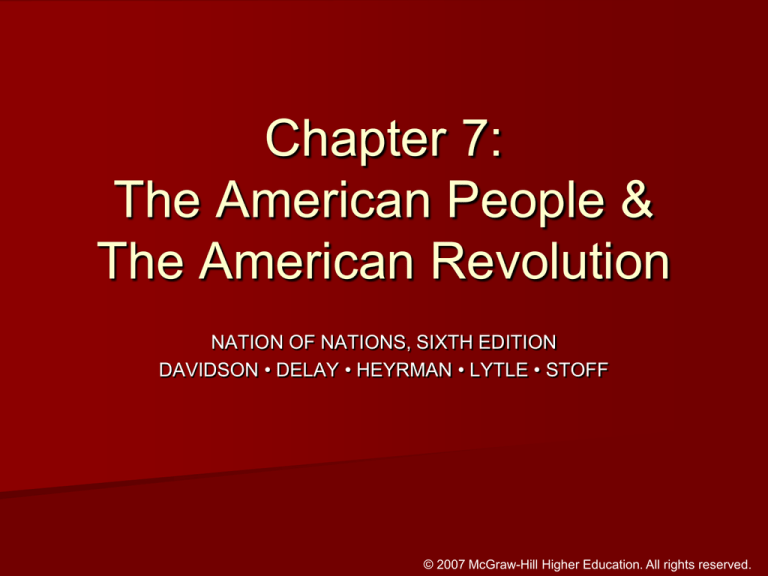
Chapter 7:
The American People &
The American Revolution
NATION OF NATIONS, SIXTH EDITION
DAVIDSON • DELAY • HEYRMAN • LYTLE • STOFF
© 2007 McGraw-Hill Higher Education. All rights reserved.
2
Preview
“Would Americans actually fight for
independence? Even after the Battle of Bunker
Hill, the answer was not clear. But British
victories in the North were countered by an
American triumph at Saratoga, convincing the
French to commit to a crucial alliance with the
United States...”
© 2007 McGraw-Hill Higher Education. All rights reserved.
3
The Highlights
The Decision for Independence
The Fighting in the North
The Turning Point
The Struggle in the South
The World Turned Upside Down
© 2007 McGraw-Hill Higher Education. All rights reserved.
4
The Decision for Independence
The Second Continental Congress
– Drafted the “Olive Branch Petition” (July 1775) as a
last-ditch effort at peace
– British response was aggressive
– Governor Dunmore of Virginia offered freedom to any
slaves who fought for the British
© 2007 McGraw-Hill Higher Education. All rights reserved.
5
The Declaration
– Thomas Jefferson, age 33, selected to write the
explanation of America’s attempts at independence
– Blamed George III; affirmed government by consent
of the people
– Declaration of Independence adopted, July 4, 1776
American Loyalists
– Large pockets of loyalists, or “tories,” in the colonies,
particularly in seaboard areas and parts of the
backcountry
© 2007 McGraw-Hill Higher Education. All rights reserved.
6
© 2007 McGraw-Hill Higher Education. All rights reserved.
7
The Fighting in the North
The Two Armies at Bay
– Washington faced a powerful foe in the British army
– Cobbled together the Continental “regulars” and
colonial militias
– Trouble gaining enlistments
– “Women of the Army” were wives of poor soldiers
who did support work in exchange for half-rations
© 2007 McGraw-Hill Higher Education. All rights reserved.
8
Laying Strategies
– British assumed that the rebellion could be quashed
by focusing on Massachusetts resistance
– By 1776, British enlarged target to New England
– Problems in British military leadership: William and
Richard Howe
The Campaigns in New York and New Jersey
– Continental victories at Trenton and Princeton
spurred support for the rebellion
© 2007 McGraw-Hill Higher Education. All rights reserved.
9
Capturing Philadelphia
– Summer 1777: British focus on Philadelphia
– Washington’s army defeated at Brandywine and
Germantown
– British conduct during capture of the city in the fall of
1777 engendered hatred, strengthening support for
American cause
Disaster at Saratoga
– Just days after the capture of Philadelphia, Americans
achieve most significant victory to that point of the war
in New York
– Victory convinced France to help Americans
© 2007 McGraw-Hill Higher Education. All rights reserved.
10
© 2007 McGraw-Hill Higher Education. All rights reserved.
11
The Turning Point
The American Revolution Becomes a Global
War
– Benjamin Franklin the key figure in strengthening the
French-American alliance
Winding Down the War in the North
– Winter of 1778: a low point for Continental Army at
Valley Forge
– Series of army uprisings, 1779-81
© 2007 McGraw-Hill Higher Education. All rights reserved.
12
War in the West
– Contest between the British and Americans over
Indian alliances
– Most tribes tried to remain neutral, but generally lost
power during course of conflict
The Home Front in the North
– Devastation from war continued to produce social,
economic, and political problems
– Daughters of Liberty remained vigilant supporters of
war effort
© 2007 McGraw-Hill Higher Education. All rights reserved.
13
© 2007 McGraw-Hill Higher Education. All rights reserved.
14
The Struggle in the South
The Siege of Charleston
– British captured Savannah, Georgia in 1778
– Moved on to Charleston, which surrendered in 1780
“Despite their armed presence in the North, the British
had come to believe that their most vital aim was to
regain their colonies in the mainland South.”
© 2007 McGraw-Hill Higher Education. All rights reserved.
15
The Partisan Struggle in the South
– The fall of Charleston energized the loyalist
movement on the frontier
– Rebels and loyalists battled for the backcountry, both
committing brutal acts
– Major American defeat at Camden, S.C.
© 2007 McGraw-Hill Higher Education. All rights reserved.
16
Greene Takes Command
– Defeated general at Camden, Horatio Gates,
replaced by Nathaniel Greene
– Greene began unconventional campaign against
superior British forces
– Southern militia units stemmed the British advance
northward
© 2007 McGraw-Hill Higher Education. All rights reserved.
17
African Americans in the Age of Revolution
– Black Americans made up one-third of southern
population
– Dunmore’s offer of freedom in 1774 sparked white
fears of slave rebellion that never materialized
– African Americans sought liberty by fighting for both
sides: approximately 55,000 fled to freedom behind
British lines and to the North
“The British also lost in the Carolinas because they did
not seek greater support from those southerners who
would have fought for liberty with the British—African
American slaves.”
© 2007 McGraw-Hill Higher Education. All rights reserved.
18
The World Turned Upside Down
Surrender at Yorktown
– Cornwallis waiting for British navy, which did not
arrive in time
– British surrounded by American and French troops,
and by French navy
– Cornwallis surrendered, October 19, 1781
“Despite his losses in the Carolinas, Cornwallis still
believed that he could score a decisive victory against
the Continental Army. The theater he chose for that
showdown was the Chesapeake.”
© 2007 McGraw-Hill Higher Education. All rights reserved.
19
The Significance of a Revolution
– American citizen-soldiers fought on their own terms
– the Continental Army, whose ranks contained a
disproportionate number of the poorest Americans,
bore the brunt of the successful rebellion
– With the end of the war, what awaited the
revolutionaries as they tried to build a new nation?
© 2007 McGraw-Hill Higher Education. All rights reserved.






